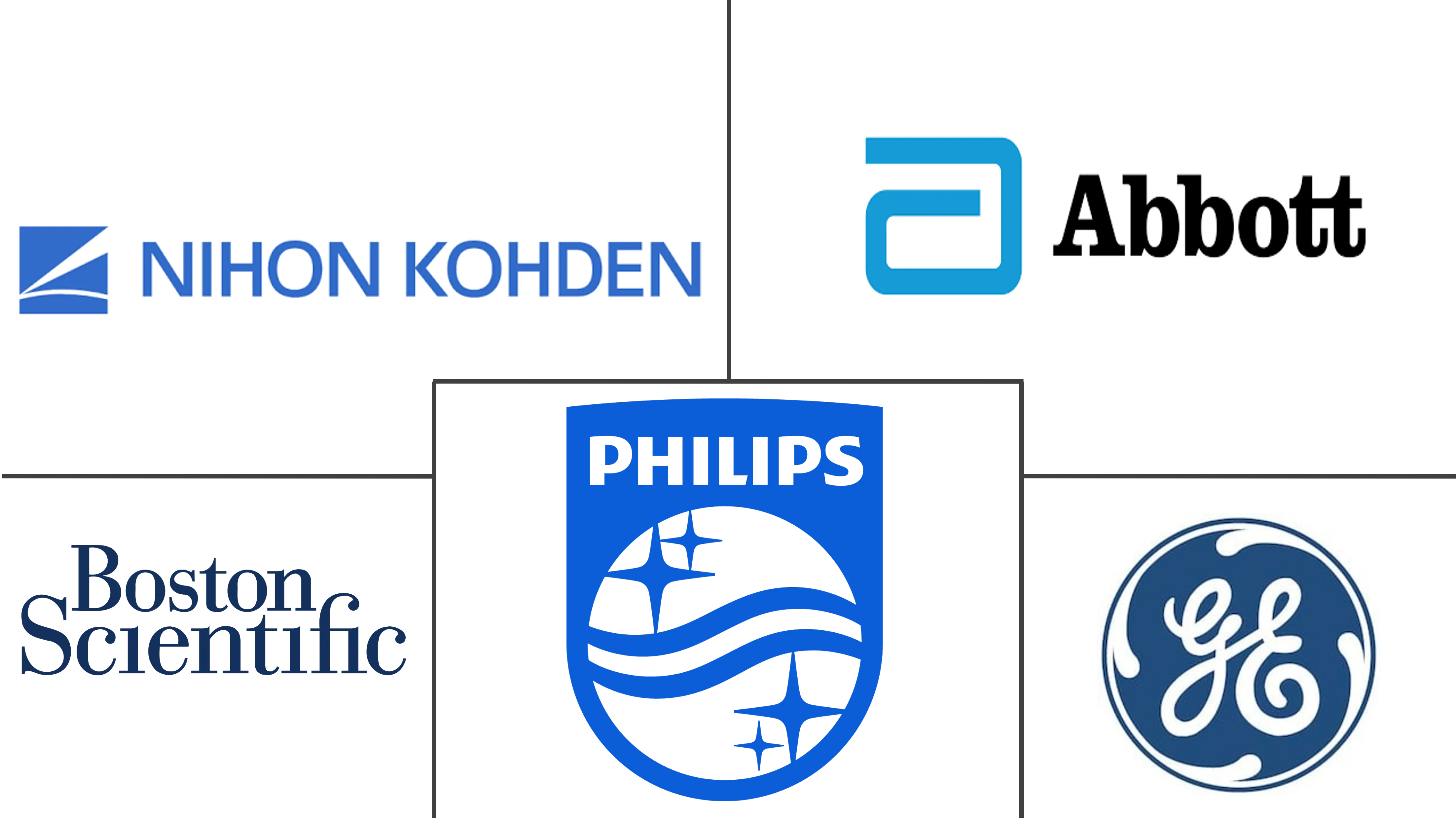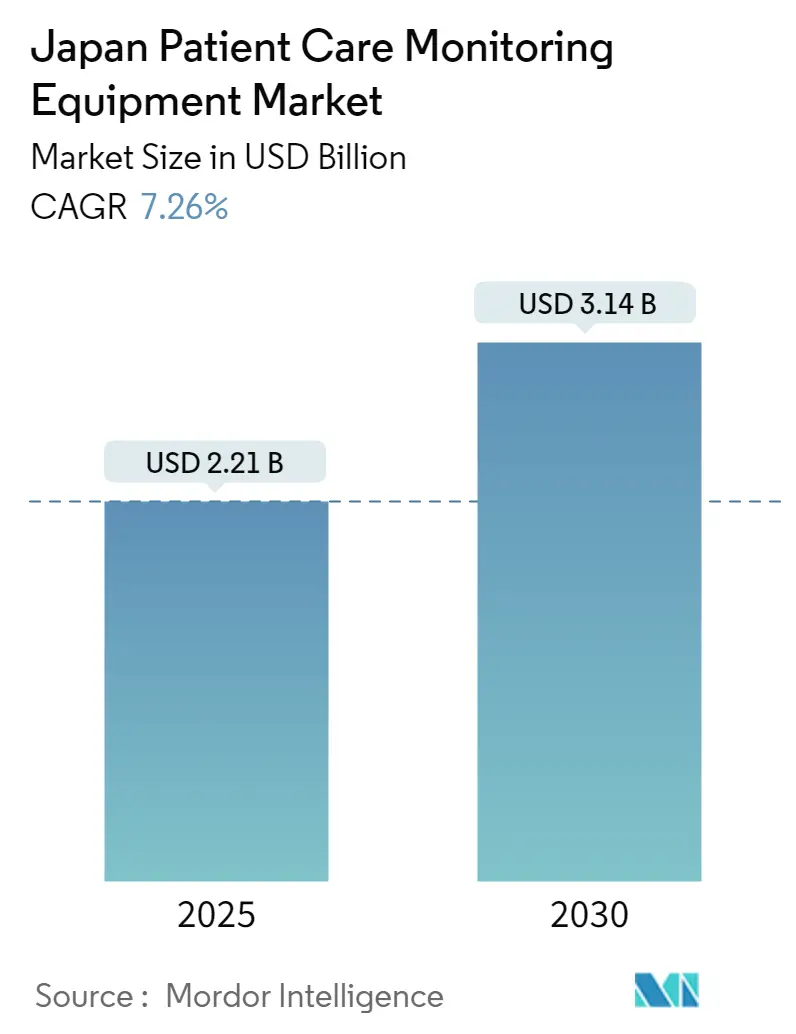
Japan Patient Care Monitoring Equipment Market Analysis by Mordor Intelligence
The Japan Patient Care Monitoring Equipment Market size is estimated at USD 2.21 billion in 2025, and is expected to reach USD 3.14 billion by 2030, at a CAGR of 7.26% during the forecast period (2025-2030).
- The COVID-19 pandemic positively impacted market growth. The demand for wearable devices and patient monitoring devices has increased during the pandemic period as they allow contactless communication and tracking of medical conditions by clinicians. For instance, according to an article published by Mainichi Japan's National Daily in September 2021, it was observed that the demand for pulse oximetry increased in Japan due to the COVID-19 pandemic. The spread and early diagnosis of COVID-19 were determined through the remote monitoring of vital signs such as skin and body temperature, respiratory rate, pulse rate, heart rate, and blood oxygen level, which are related to COVID-19. Also, as per another article published in Nature Public Health Emergency Collection in February 2023, hypertensive patients were given a home blood pressure (BP) monitoring device that was connected to a web server, and local medical facilities were notified if their hypertensive patients had a consistent increase in BP levels in Japan. As per the World Health Organization (WHO) March 2023 update, 33.4 million confirmed cases of COVID-19 were reported in Japan. Thus, the increasing number of COVID-19 cases among the population is expected to increase the need to monitor oxygen levels, which is expected to increase the demand for patient monitoring devices such as oximetry and BP monitoring, which in turn fueled the market growth during the pandemic.
- Certain factors that are propelling the growth of the market are the rising burden of chronic diseases, such as neurological diseases, and the growing preference for home and remote monitoring devices. For instance, an article published in Clinical Parkonism & Related Disorder Journal in May 2022 stated that the prevalence rate of Parkinson's disease in the surveyed Japanese population was 279.7 per 100,000 individuals. Thus, the high burden of neurological diseases among Japanese people is expected to boost the need for regular monitoring to prevent health risks, which is expected to increase the demand for patient care monitoring devices, thereby accelerating the market growth.
- In addition, the rising geriatric population is also contributing to the growth of the studied market. For instance, according to the 2022 statistics published by the United Nations Population Fund, in Japan, a large proportion of the living population is aged 15-64 and accounts for 59% in 2022. In addition, as per the same source, 29% of the population is aged 65 years and above in 2022. Thus, the rising geriatric populations are more prone to develop chronic diseases that require proper monitoring and diagnosis, which is expected to increase the adoption of monitoring devices to regularly monitor their condition and status, thereby propelling the growth of the studied market.
- Furthermore, the rising company activities in developing advanced patient monitoring devices are also contributing to the market growth. For instance, in May 2021, Xenoma Inc., a Tokyo-based start-up spun off from the University of Tokyo, launched the e-skin Sleep T-shirt that is worn to bed to provide sleep diagnosis. The shirt comes with a small electronic device that is affixed to the pocket. The device can measure heartbeat, body movements, and temperature on the shirt's interior. The innovative technology is intended to assist patients with abnormal heart rhythms by more clearly documenting unexplained syncope.
- However, factors such as the resistance from healthcare professionals towards the adoption of patient monitoring systems and the high cost of technology are likely to restrain the market growth over the forecast period.
Japan Patient Care Monitoring Equipment Market Trends and Insights
Remote Patient Monitoring Devices are Expected to Show a Significant Growth Rate in the Japan Patient Care Monitoring Equipment Market Over The Forecast Period
- Remote patient monitoring (RPM) devices allow providers to monitor, report, and analyze their patient's acute or chronic conditions outside the hospital or clinic setting. They enable the practitioner to understand the patient's disease state and take preventative clinical actions.
- The remote patient monitoring segment is expected to witness significant growth over the forecast period owing to factors such as the rising prevalence of chronic diseases such as cardiovascular diseases, diabetes, hypertension, respiratory diseases, neurological diseases, and others and the growing preference for home and remote monitoring. For instance, according to the International Diabetes Federation 2022 statistics, 11,005 thousand people in Japan were living with diabetes in 2021. In addition, this number is projected to reach 10,542.7 thousand by 2030. The high blood sugar caused by diabetes can damage the nerves that control the heart and blood vessels, leading to a variety of cardiovascular diseases like coronary artery disease and stroke, which can narrow the arteries. This is anticipated to raise the need for monitoring glucose levels, blood pressure, and other activities, which is expected to increase the demand for monitoring devices that can provide data to physicians to help them more effectively evaluate patient conditions and react quickly to any abnormalities, thereby propelling the market growth.
- Furthermore, according to an article published in November 2022 in the Journal of Medical Internet Research, telemonitoring is widely used to reduce mortality and improve self-management of chronic disease. Patients also report good satisfaction and adherence to a digital device for remote patient monitoring. Therefore, the growing adoption of telemonitoring and remote patient monitoring is expected to boost the segment's growth during the forecast period.
- Furthermore, the rising product launches are likely to contribute to the market growth over the forecast period. For instance, in March 2022, the Japanese Ministry of Health, Labour, and Welfare approved the expansion of reimbursement coverage for Abbott's FreeStyle Libre system to include all people with diabetes who use insulin at least once a day. The expanded coverage enables more people with diabetes to access the glucose data needed to manage their condition without the routine fingersticks associated with conventional blood glucose monitoring. Also, in July 2021, Terumo Corporation launched the Dexcom G6 continuous glucose monitoring (CGM) system, a medical device that supports diabetes control, in Japan. The system allows real-time glucose monitoring by using a compact, wearable sensor and transmitter to measure and automatically transfer glucose values wirelessly to a smart device or receiver every five minutes. Such launches and government initiatives are estimated to boost the demand for remote patient monitoring in the country during the analysis period.
- Therefore, due to the aforementioned factors, such as the high burden of chronic diseases, the adoption for remote patient monitoring, and the advantages offered, the segment is expected to witness healthy growth over the forecast period.
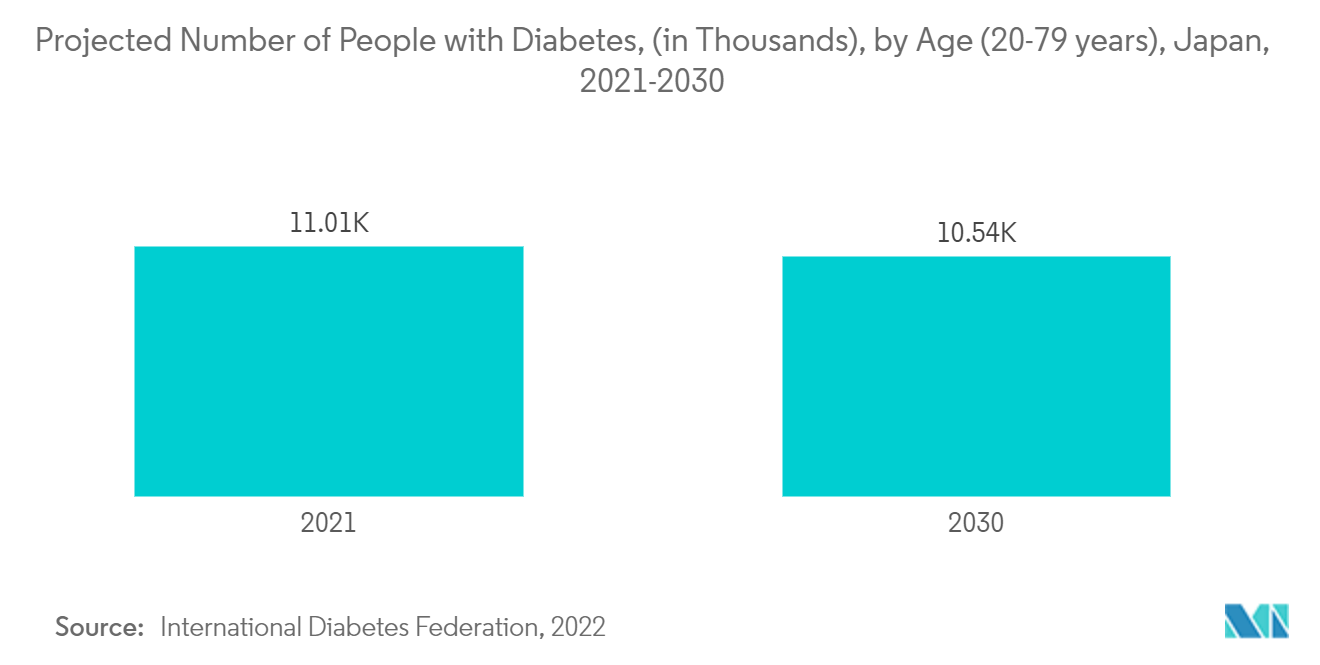
Cardiology Segment is Expected to Hold a Significant Market Share Over The Forecast Period
- Patient care monitoring equipment plays a vital role in the management and monitoring of cardiovascular diseases. The diseases include heart attack, stroke, cardiac arrhythmia, etc. Some of the equipment used in cardiological monitoring include cardiac rhythm management devices.
- A high burden of cardiovascular diseases in the country is likely to propel the growth of the segment over the analysis period. For instance, a research study published in BioMed Central Public Health Journal stated that in Japan, cardiovascular diseases (CVD) are among the top contributors to the disease burden that, accounts for over 20% of the total medical expenditure consumption in Japan. Also, the high burden of smoking in the country is associated with cardiovascular risks, thereby boosting the segment's growth. For instance, an article published in the Journal of Epidemiology in June 2021 reported the prevalence of smoking was 38.4% in Japan. Therefore, the high prevalence of CVD and smoking is projected to boost the usage of patient care monitoring equipment for the proper treatment and prevention of the condition, thereby propelling segment growth over the forecast period.
- Several market players are engaged in partnerships, launches, and acquisitions that support the market growth in the country. For instance, in September 2021, Astellas, Nitto Denko Corporation, and M. Heart Co., Ltd. collaborated to develop a solution for the early detection of atrial fibrillation using a disposable Holter ECG device and artificial intelligence (AI)-based Analysis Service. Such collaborations are projected to boost the usage of cardiovascular patient monitoring equipment in the country and propel the segment growth during the analysis period.
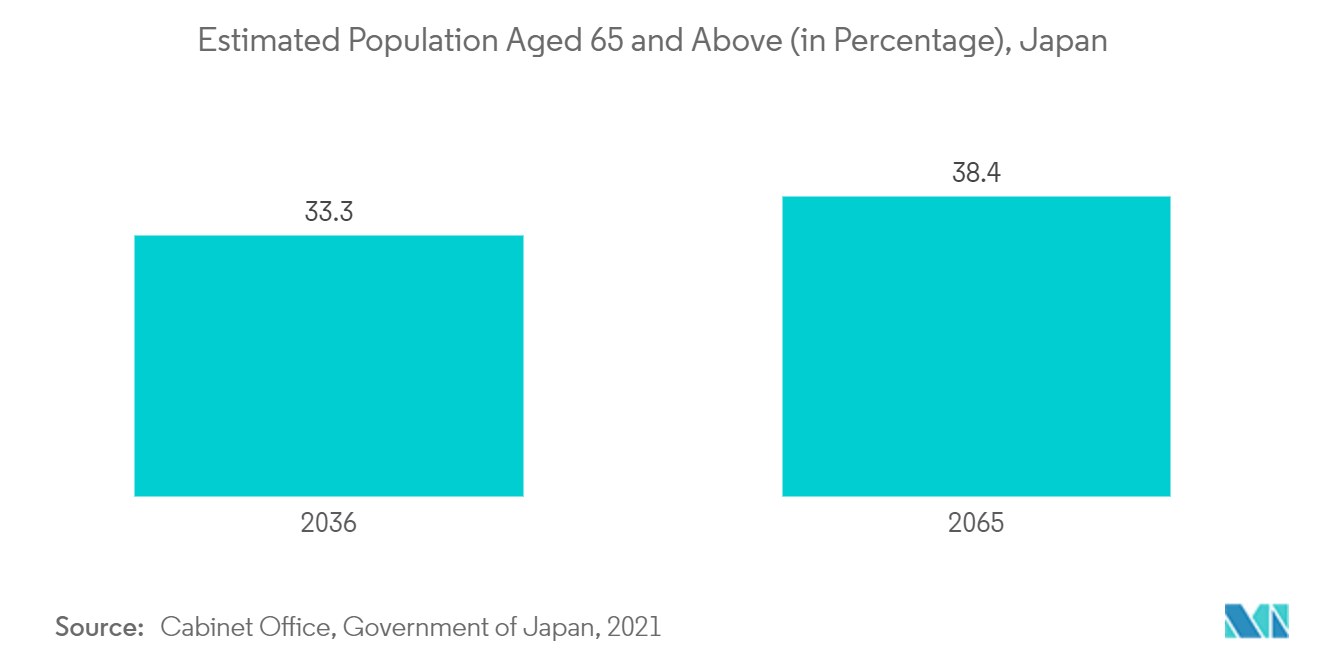
Competitive Landscape
The Japan patient monitoring market is fragmented. Some of the market players are Abbott Laboratories, Boston Scientific Corporation, Koninklijke Philips N.V., General Electric Company (GE Healthcare), Nihon Kohden Corporation, Siemens Healthcare GmBH, and others.
Japan Patient Care Monitoring Equipment Industry Leaders
-
Abbott Laboratories
-
General Electric Company (GE Healthcare)
-
Boston Scientific Corporation
-
Nihon Kohden Corporation
-
Koninklijke Philips N.V.
- *Disclaimer: Major Players sorted in no particular order
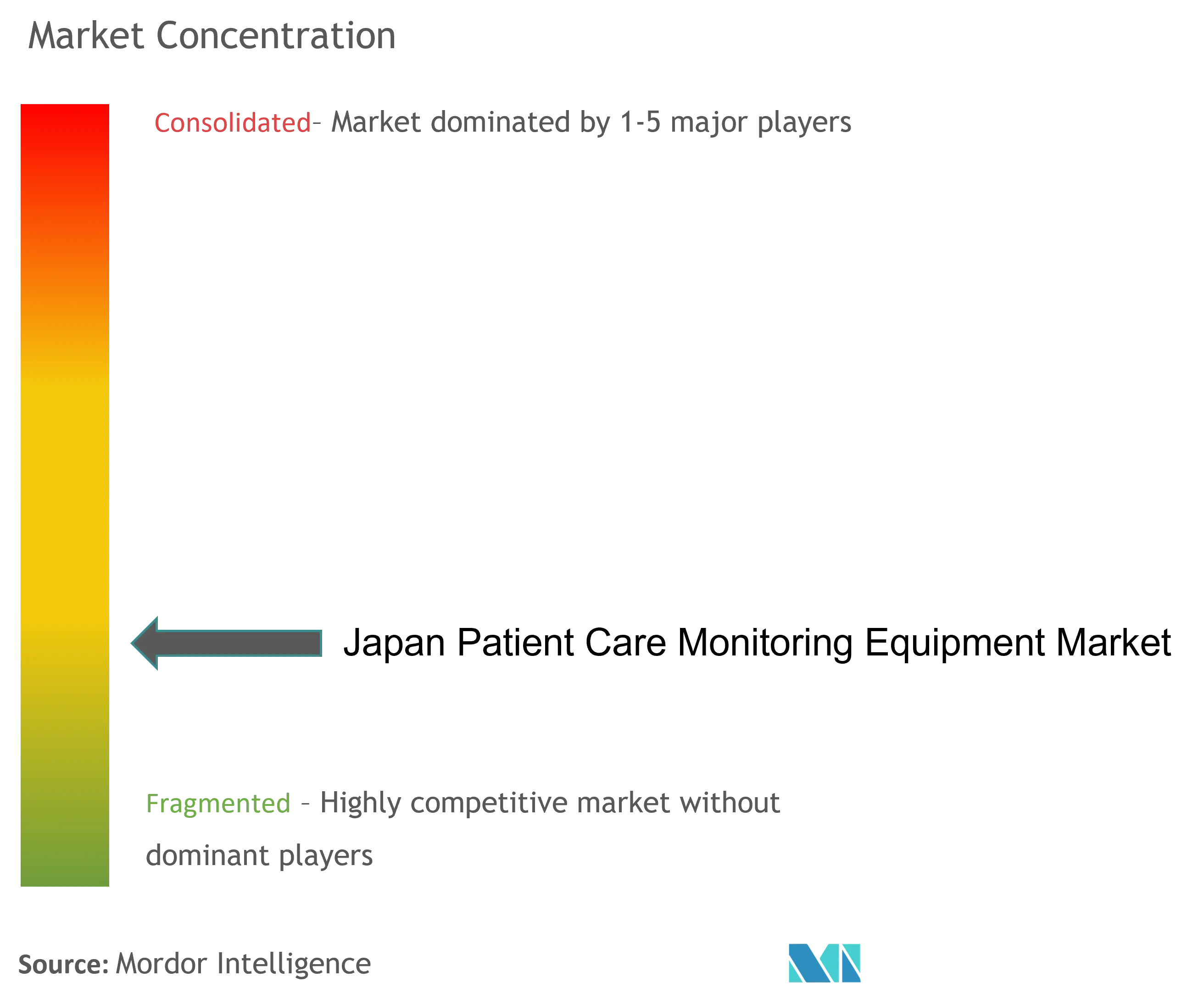
Recent Industry Developments
- May 2022: Terumo Corporation changed the indication for the Dexcom G6 CGM System in Japan. With this additional indication, the system functions as the only real-time continuous glucose monitoring (RT-CGM) system in Japan that can be used primarily for managing blood glucose levels on a day-to-day basis without the supplementary use of a blood glucose meter.
- March 2022: SoftBank Corp. entered into an agreement with Pear Therapeutics to develop a Japanese-language digital therapeutic for the treatment of sleep/wake disorders for the Japanese market.
Japan Patient Care Monitoring Equipment Market Report Scope
As per the scope of this report, patient monitoring systems are collections of machines or equipment used for continuously monitoring patients' vital signs and warning systems to identify and document changes in their wellness. They collect and track patient health data using digital technology and transfer it electronically to healthcare professionals to aid in assessing, diagnosing, and ultimately treating health conditions.
The Japan patient care monitoring equipment market is segmented by type of device (hemodynamic monitoring devices, neuromonitoring devices, cardiac monitoring devices, multi-parameter monitors, respiratory monitoring devices, remote patient monitoring devices, and other types of devices), application (cardiology, neurology, respiratory, fetal and neonatal, weight management and fitness monitoring, and other applications), and end-user (home healthcare, hospitals and clinics, and other end-users).
The report offers the value (in USD) for the above segments.
| Hemodynamic Monitoring Devices |
| Neuromonitoring Devices |
| Cardiac Monitoring Devices |
| Multi-parameter Monitors |
| Respiratory Monitoring Devices |
| Remote Patient Monitoring Devices |
| Other Types of Devices |
| Cardiology |
| Neurology |
| Respiratory |
| Fetal and Neonatal |
| Weight Management and Fitness Monitoring |
| Other Applications |
| Home Healthcare |
| Hospitals and Clinics |
| Other End-Users |
| By Type of Device | Hemodynamic Monitoring Devices |
| Neuromonitoring Devices | |
| Cardiac Monitoring Devices | |
| Multi-parameter Monitors | |
| Respiratory Monitoring Devices | |
| Remote Patient Monitoring Devices | |
| Other Types of Devices | |
| By Application | Cardiology |
| Neurology | |
| Respiratory | |
| Fetal and Neonatal | |
| Weight Management and Fitness Monitoring | |
| Other Applications | |
| By End-Users | Home Healthcare |
| Hospitals and Clinics | |
| Other End-Users |
Key Questions Answered in the Report
How big is the Japan Patient Care Monitoring Equipment Market?
The Japan Patient Care Monitoring Equipment Market size is expected to reach USD 2.21 billion in 2025 and grow at a CAGR of 7.26% to reach USD 3.14 billion by 2030.
What is the current Japan Patient Care Monitoring Equipment Market size?
In 2025, the Japan Patient Care Monitoring Equipment Market size is expected to reach USD 2.21 billion.
Who are the key players in Japan Patient Care Monitoring Equipment Market?
Abbott Laboratories, General Electric Company (GE Healthcare), Boston Scientific Corporation, Nihon Kohden Corporation and Koninklijke Philips N.V. are the major companies operating in the Japan Patient Care Monitoring Equipment Market.
What years does this Japan Patient Care Monitoring Equipment Market cover, and what was the market size in 2024?
In 2024, the Japan Patient Care Monitoring Equipment Market size was estimated at USD 2.05 billion. The report covers the Japan Patient Care Monitoring Equipment Market historical market size for years: 2019, 2020, 2021, 2022, 2023 and 2024. The report also forecasts the Japan Patient Care Monitoring Equipment Market size for years: 2025, 2026, 2027, 2028, 2029 and 2030.
Page last updated on:
Japan Patient Care Monitoring Equipment Market Report
Statistics for the 2025 Japan Patient Care Monitoring Equipment market share, size and revenue growth rate, created by Mordor Intelligence™ Industry Reports. Japan Patient Care Monitoring Equipment analysis includes a market forecast outlook for 2025 to 2030 and historical overview. Get a sample of this industry analysis as a free report PDF download.
